(a) Deduce the expression for the torque acting on a dipole of dipole moment p in the presence of a uniform electric field E⃗.
(b) Consider two hollow concentric spheres, S1 and S2, enclosing charges 2Q and 4Q respectively as shown in the figure.
(i) Find out the ratio of the electric flux through them.
(ii) How will the electric flux through the sphere S1 change if a medium of dielectric constant 'εr' is introduced in the space inside S1 in place of air ?
Deduce the necessary expression.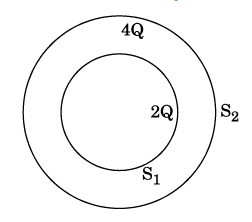
a) Dipole in a uniform electric field:
Consider an electric dipole consisting of charges −q and +q and of length 2a placed in a uniform electric field making an angle θ with the electric field.
Forces acting on the two charges of the dipole, are +qE and -qE.
That is, the net force on the dipole is equal and opposite.
So, Force = 0
Two forces are equivalent to torque having magnitude given by,
Therefore, torque acting on the dipole is given by, 
b) i) Charge enclosed by sphere S1 = 2Q
Charge enclosed by sphere S2 = 2Q + 4Q = 6Q
Now, using Gauss law, electric flux enclosed by sphere S1 and S2 is given by, 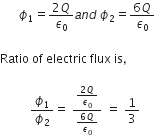
ii) If a medium of dielectric constant 'εr' is introduced in the space inside S1 in place of air, electric flux becomes

That is, electric flux decreases.
(i) Use Gauss’s law to find the electric field due to a uniformly charged infinite plane sheet. What is the direction of field for positive and negative charge densities?
(ii) Find the ratio of the potential differences that must be applied across the parallel and series combination of two capacitors C1 and C2 with their capacitances in the ratio 1 : 2 so that the energy stored in the two cases becomes the same.
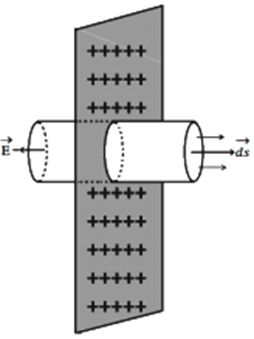
 on both sides of the sheet. Let a point be at a distance a from the sheet at which the electric field is required.
on both sides of the sheet. Let a point be at a distance a from the sheet at which the electric field is required. Area of the cross section of the gaussian cylinder.
Area of the cross section of the gaussian cylinder.







(i) If two similar large plates, each of area A having surface charge densities 1s and 2s are separated by a distance d in air, find the expressions for
(a) field at points between the two plates and on outer side of the plates. Specify the direction of the field in each case.
(b) the potential difference between the plates.
(c) the capacitance of the capacitor so formed.
(ii) Two metallic spheres of radii R and 2R are charged so that both of these have same surface charge density s. If they are connected to each other with a conducting wire, in which direction will the charge flow and why ?
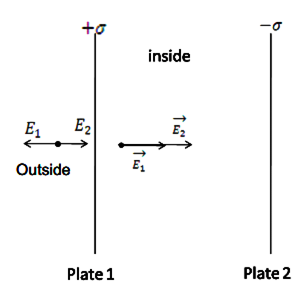







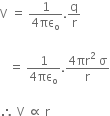
Tips: -
While travelling back to his residence in the car, Dr. Pathak was caught up in a thunderstorm. It became very dark. He stopped driving the car and waited for thunderstorm to stop. Suddenly he noticed a child walking alone on the road. He asked the boy at his residence. The boy insisted that Dr. Pathak should meet his parents. The parents expressed their gratitude to Dr. Pathak for his concern for safety of the child.
Answer the following questions based on the above information:
(a) Why is it safer to sit inside a car during a thunderstorm?
(b) Which two values are displayed by Dr. Pathak in his actions?
(c) Which values are reflected in parents’ response to Dr. Pathak?
(d) Give an example of a similar action on your part in the past from everyday life.
a) On the basis of electrostatic screening, no electric field exists inside the charged conducting body. During lightening a shower of the charged particles falls on the earth. So it would be safer to sit inside the car.
(b) Dr. Pathak knows the result of lightening during thunderstorm; so he displayed two actions;
(i) Shows love, kindness and sympathy to the child.
(ii) Keeping in view the safety of the child, he allow the boy to sit in the car till the thunderstorm stopped.
(c) Parent meets Dr. Pathak; and express their gratitude and heart felt thank for providing the safety to the child from lightning and thunderstorm.
(d) Many of us have read in the newspaper that the person either working in the field or in open space have lost their life during thunderstorm. So the persons belonging to villages must be given advices that they should remain inside the houses during thunderstorm.

